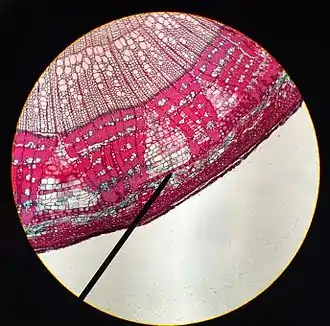Cambium
A cambium (plural cambia or cambiums), in plants, is a tissue layer that provides partially undifferentiated cells for plant growth. It is found in the area between xylem and phloem. A cambium can also be defined as a cellular plant tissue from which phloem, xylem, or cork grows by division, resulting (in woody plants) in secondary thickening. It forms parallel rows of cells, which result in secondary tissues.[1]

Cork cambium viewed under a microscope
There are several distinct kinds of cambium found in plant stems and roots:
- Cork cambium, a tissue found in many vascular plants as part of the periderm.
- Unifacial cambium, which ultimately produces cells to the interior of its cylinder.
- Vascular cambium, a lateral meristem in the vascular tissue of plants.
This article is issued from Wikipedia. The text is licensed under Creative Commons - Attribution - Sharealike. Additional terms may apply for the media files.